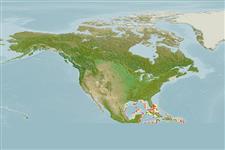分类 / Names
俗名 | 同种异名 | Catalog of Fishes(属, 种) | ITIS | CoL | WoRMS | Cloffa
Teleostei >
Gobiiformes (Gobies) >
Gobiidae (Gobies) > Gobiinae
Etymology: Palatogobius: Latin, palatum = pertaining to palate and/or teeth + Latin, gobius = gudgeon (Ref. 45335); grandoculus: Named for its very large eyes.
More on author: Greenfield.
Environment: milieu / climate zone / depth range / distribution range
生态学
海洋 深海底的; 深度上下限 253 - 276 m (Ref. 43477). 深水域
Western Central Atlantic: Caribbean Sea.
中西大西洋: 加勒比海。
大小 / 重量 / 年龄
Maturity: Lm ? range ? - ? cm
Max length : 3.2 cm SL 雄鱼/尚未辨别雌雄; (Ref. 43477)
简单描述
检索表 | 型态特徵 | 形态测量图
背棘 (总数) : 8; 背的软条 (总数) : 17 - 18; 臀棘: 1; 臀鳍软条: 18 - 19; 脊椎骨: 27. Eyes very large, situated dorsally. Mouth rather large, very oblique, protractile. Differs from P. paradoxus by having a much larger eye, shorter snout, and narrower interorbital width. Body scales extend forward on sides past the first dorsal fin origin (vs. extending forward only to beneath the soft dorsal fin).
眼非常大的, 位于背部。 嘴相当大,非常斜的,和可伸出的。 藉由有一个有别于 P. paradoxus 大很多的眼,比较短的吻与较狭窄的眼间骨宽度。 身体鳞片越过第一背鳍起源在侧边上向前延伸。 (vs. 只有向前延伸到在软的背鳍之下)
Minimum depth from Ref. 58018. Occurs in coral rubble and sand (Ref. 92840).
Life cycle and mating behavior
成熟度 | 繁殖 | 产卵场 | 卵 | 孕卵数 | 仔鱼
中西大西洋: 加勒比海。
Greenfield, D.W., 2002. Palatogobius grandoculus: a new deep-water Western Caribbean gpby (Teleostei: Gobiidae). Copeia 2002(3):716-719. (Ref. 43477)
世界自然保护联盟红皮书 (Ref. 130435: Version 2024-2)
人类利用
工具
特别资料
下载 XML
网络资源
Estimates based on models
Preferred temperature (Ref.
123201): 5.9 - 14.3, mean 10.2 °C (based on 102 cells).
Phylogenetic diversity index (Ref.
82804): PD
50 = 0.7500 [Uniqueness, from 0.5 = low to 2.0 = high].
Bayesian length-weight: a=0.01023 (0.00477 - 0.02194), b=3.01 (2.83 - 3.19), in cm total length, based on LWR estimates for this (Sub)family-body shape (Ref.
93245).
营养阶层 (Ref.
69278): 3.1 ±0.3 se; based on size and trophs of closest relatives
回复力 (Ref.
120179): 高度, 族群倍增时间少于 15个月 (Preliminary K or Fecundity.).
Fishing Vulnerability (Ref.
59153): Low vulnerability (10 of 100).
